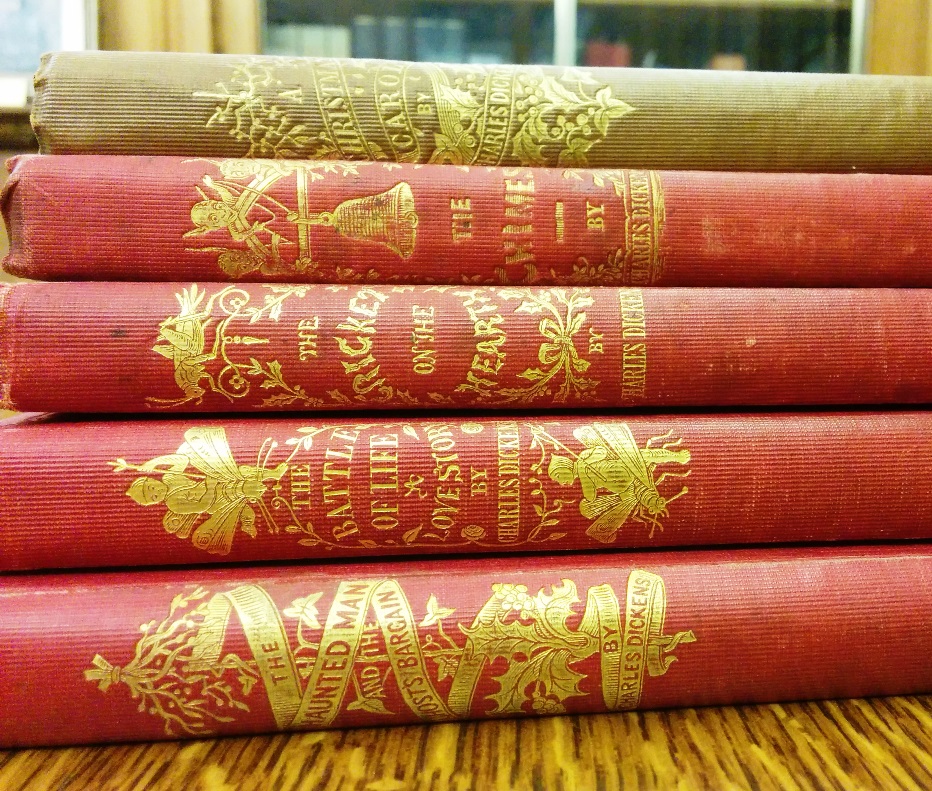Charles Dickens and His Christmas Stories

Christmas approaches, and at this time of year many of us will read, listen to, or watch adaptations of Charles Dickens’s A Christmas Carol, in Prose: Being a Ghost Story of Christmas. This story, now canonical, has in fact been immensely popular and influential since the very first day it appeared. That first edition, released on December 19, 1843, sold out almost immediately; its publisher returned to press no fewer than eight times within the first six months. Scholar-bibliographer Ruth Glancy has traced how this tale, “a truly popular work which is undeniably a masterpiece as well,” has both charmed and confounded readers and scholars ever since.
Some examples of this ghostly tale’s influence and staying power:

A Christmas Carol led a nineteenth-century Boston factory owner to give his workers a day off from work as well as free turkeys. The tale inspired the creation of a welfare campaign to provide “Tiny Tim” cots to children in need. It’s the story that President Franklin Delano Roosevelt read to his family each winter. And in England, Princess Maud read it to her family annually, during the reign of King Edward VII. A Christmas Carol continues, year after year, to be reworked, adapted, dramatized, enjoyed at home, and read in public settings. Perhaps you were lucky enough to have attended WYNC and WQXR’s dramatic performance of it just last week!
While most of us know our way around A Christmas Carol by now, perhaps less familiar are the dozens of Christmas stories (all part of the George Arents Collection) that Charles Dickens penned in the twenty-five years that followed its publication. After A Christmas Carol came four more Christmas books:

The Chimes: A Goblin Story of Some Bells that Rang an Old Year Out and a New Year In (Christmas 1844)
This strange tale revolves around a wedding, an orphan, an evil rich man, and some frightening goblins. Or was it all a dream, resulting from our protagonist Trotty Veck having had too much tripe at dinner?


The Cricket on the Hearth: A Fairy Tale of Home (Christmas 1845)
Almost as popular as A Christmas Carol in its time, this tale includes a mysterious man in disguise, a dog named Boxer, some possible infidelity, a young blind heroine, a nanny, and—of course—a cricket.


The Battle of Life: A Love Story (Christmas 1846)
Perhaps only Dickens could offer up a happy ending to this troubling tale of a missing sister and a sinister elopement scheme, all set on a one-time battlefield that still bears the relics of a host of dead men and horses.


The Haunted Man and the Ghost’s Bargain: A Fancy for Christmas-Time (Christmas 1848)
In this tale, a gloomy chemistry professor says things like, “Another Christmas come, another year gone. . . More figures in the lengthening sum of recollection that we work and work at to our torment, till Death idly jumbles all together, and rubs all out.” But when his wish to forget his distressing past is granted, he gets more than he bargained for.

Following on the heels of these five standalone books, Dickens took a new approach to holiday storytelling. He began to write and edit special Christmas-themed issues of Household Words, a twopenny journal he launched in 1850. For each “Christmas number” of Household Words, Dickens collaborated with other prominent writers, including Wilkie Collins and Elizabeth Gaskell. Through these tales, Dickens as author and editor continued to explore themes we still associate with Christmas storytelling: the comfort of memory, the role of traditions and rituals, the invaluable presence of family and friends, and the power of generosity and goodwill.
To learn all about the history of A Christmas Carol as well as all Dickens’s many other Christmas stories, you can do no better than to start by consulting Ruth Glancy’s Dickens's Christmas Books, Christmas Stories, and Other Short Fiction : an Annotated Bibliography. She points curious readers to the locations of primary sources and various editions as well as to translations; abridgements; stage, film, radio, and musical adaptations; reviews; commentaries; and scholarly studies. And to learn more about Dickens’s life, including how he just might be to blame for our obsession with having a snowy Christmas day, you can read The Man Who Invented Christmas.
Do you have a favorite Christmas story that you return to again and again? If you would like to find a new Christmas story to read and share with your friends and family, there are hundreds and hundreds of Christmas-themed stories waiting for you at the Library. As for myself, Dickens is great, but I like to read Nancy Mitford's Christmas Pudding this time each year. Happy holiday reading—and if you are so inclined, enjoy a bit of smoking bishop just like Ebenezer Scrooge and Bob Cratchit do in the happy conclusion of A Christmas Carol!

Read E-Books with SimplyE
 With your library card, it's easier than ever to choose from more than 300,000 e-books on SimplyE, The New York Public Library's free e-reader app. Gain access to digital resources for all ages, including e-books, audiobooks, databases, and more.
With your library card, it's easier than ever to choose from more than 300,000 e-books on SimplyE, The New York Public Library's free e-reader app. Gain access to digital resources for all ages, including e-books, audiobooks, databases, and more.
If you don’t have an NYPL library card, New York State residents can apply for a digital card online or through SimplyE (available on the App Store or Google Play).
Need more help? Read our guide to using SimplyE.